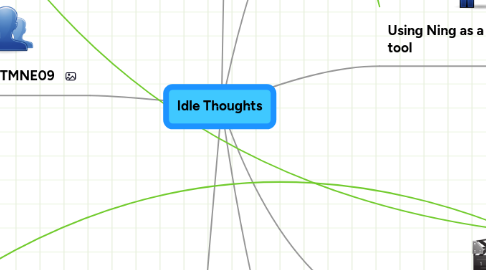
1. Ideas from TMNE09
1.1. How do you set up a TM?
1.1.1. Question asked of CHarte via Ning
1.2. Independent Learning
1.2.1. Example at TMNE was with Y12
1.2.2. What year groups would this approach work with?
1.2.2.1. Surely all of them, to an extent - but easier to start with VI form?
1.2.2.2. While some classes MIGHT benefit - can be a huge risk and requires some level of maturity
1.2.2.3. Start at the top and work down the school, expanding as you go?
1.2.3. Is it more/less useful with coursework or exam classes?
1.3. E-Twinning
1.3.1. Collaborate with other schools on a whole range of ideas
1.3.1.1. Databases (collecting/comparing data)
1.3.1.2. Presenting information
1.3.1.3. HE - food from around the world
1.4. Early GCSE Entry
1.4.1. SLT support obviously needed
1.4.2. G&T targeted? Or subject specific excellence?
1.4.3. Would have to be extra-curricular?
1.4.4. Cost to school?
1.4.5. Benefit to school?
1.5. Presentation tools
1.5.1. Wordle
1.5.2. GoAnimate
1.5.3. Glogster
1.5.4. Prezi
1.5.5. Animoto
1.5.6. Voice Tools
1.5.6.1. Voki
1.5.6.2. Crazy Talk
1.5.6.3. Mashface
1.5.7. Wiki
1.5.8. XtraNormal
1.5.9. Museum Box
1.5.10. Comic Life (Desktop App)
1.6. Film Making
1.6.1. Links:
1.6.1.1. filminute.com (60sec)
1.6.1.2. depict.org (90sec)
1.6.1.3. northeastmovies.co.uk
1.7. Neural Impulse Actuator
1.7.1. THAT'S. JUST. COOL.
1.7.2. Stimulating discussions about technology and computing
1.7.3. While it is cool - what educational benefits are there?
1.8. PEEL
1.8.1. Look for more examples/structure
1.8.2. Brilliant example presented
1.8.2.1. Relevance to skills based subjects as well as knowledge based
1.8.2.2. Time needed to prepare exemplar levelling grids
1.8.2.2.1. How do I do that? Any guidelines out there?
1.8.3. What is there to the techniques?
1.9. Anderson's Taxonomy
2. Mind Mapping as a tool
2.1. Amazed I have not done this before
2.2. Incredibly powerful
2.3. We *use* mind maps (a little), but do we really teach how to use them well?
2.4. Link between mind mapping and independent learning
2.5. Best examples of tools:
2.5.1. Mind Meister - At a glance looks very good for building up and publishing a very detailed mind map. Collaborative. Uses OpenID.
2.5.2. Bubbl.us - Pretty interface and doesn't require a log on if you take a screen grab. Can print as nested lists/bullets. Don't *think* it's collaborative.
2.5.3. Mind42- Looks OK, not really used. Collaborative.
2.5.4. Text2mindmap - A good introduction and alternative tool
2.5.4.1. Offering a choice to those with different learning styles
2.5.5. Freemind - Desktop app, over complicated? OSS
2.6. How do you assess a mind map?
2.6.1. Definition/examples of Level 3 / 4 / 5?
2.6.2. If we are going to teach the technique, we need some way to give feedback to students
2.6.3. Remember - the software is NOT the point, the skill level is
3. Who reads blogs these days?
3.1. I tend to read blogs entries posted in Twitter
3.2. Although I subscribe to lots of blogs, I rarely open my RSS reader - feels too much like work
3.3. And so I miss lots and lots of thoughts and ideas
3.4. I use Twitter - but is that a simple replacement?
3.5. Who reads my blog? What is it for?
4. Media Ideas
4.1. Century of Faces
4.2. Filminute
4.3. Students filming/editing school events
5. Using Ning as a classroom tool
5.1. Competing with Moodle?
5.2. Competing with Mahara?
5.3. Relative merits in comparison with ELGG and Edmodo?
5.4. Would need SLT/HoD/Tech support on board
5.4.1. Chat facility could be an issue
5.4.1.1. A good one
5.4.1.1.1. Communication skills
5.4.1.1.2. Back channel
5.4.1.1.3. Social networking in a 'safe' environment
5.4.1.2. A bad one
5.4.1.2.1. Abuse in lessons
5.4.1.2.2. Filtering issues?
5.5. Can you lock it down?
5.6. Who to use it with
5.6.1. One Ning per class?
5.6.1.1. Seems a sensible start, but is it scalable?
5.6.2. One Ning per year group?
5.6.3. One Ning per school?
5.6.4. One Ning per subject area?
5.6.5. KS3? KS4? KS5?
